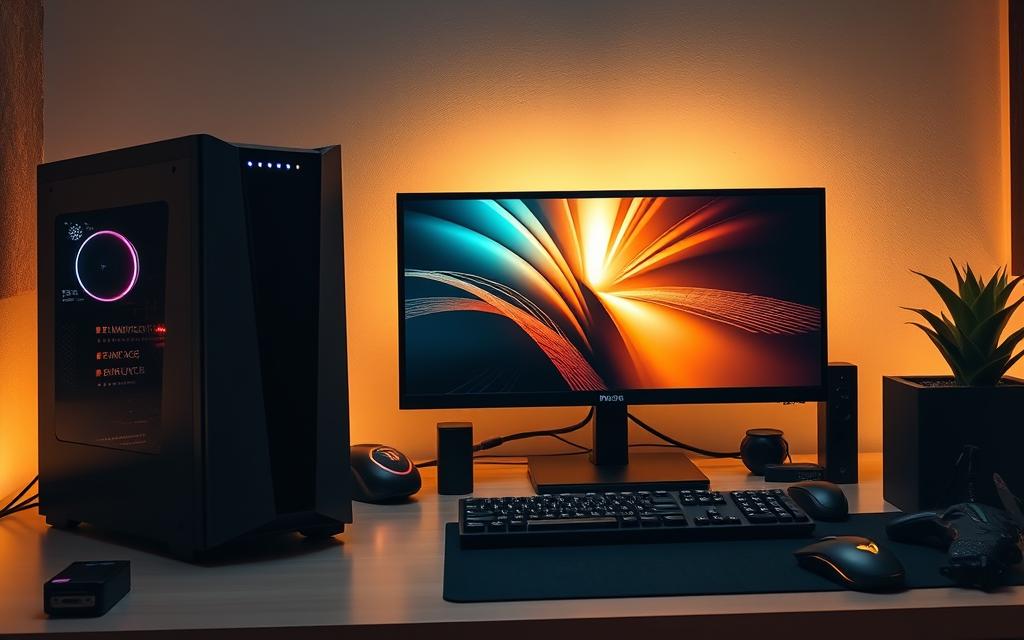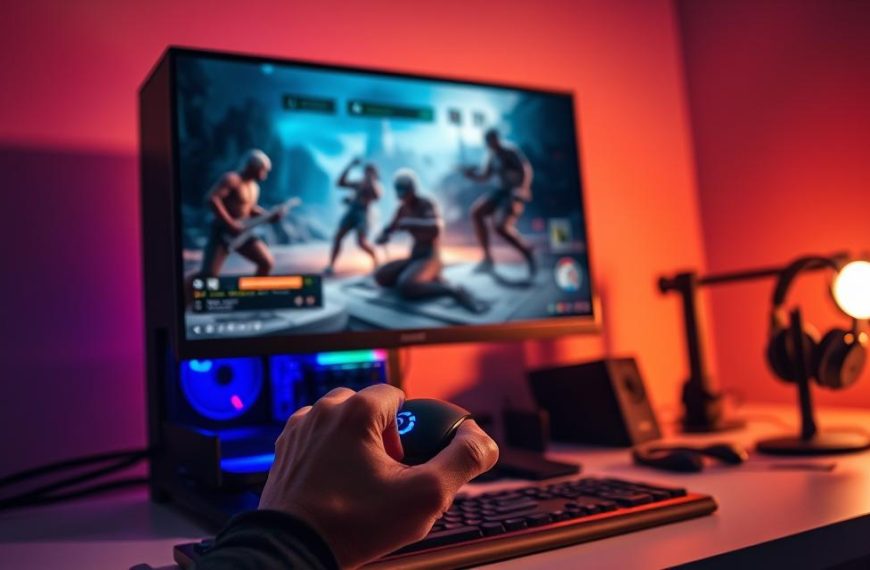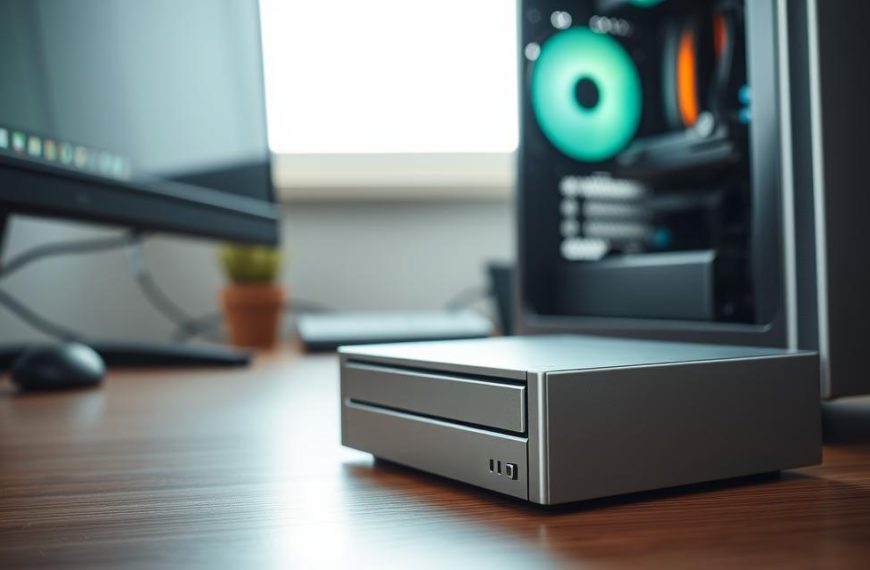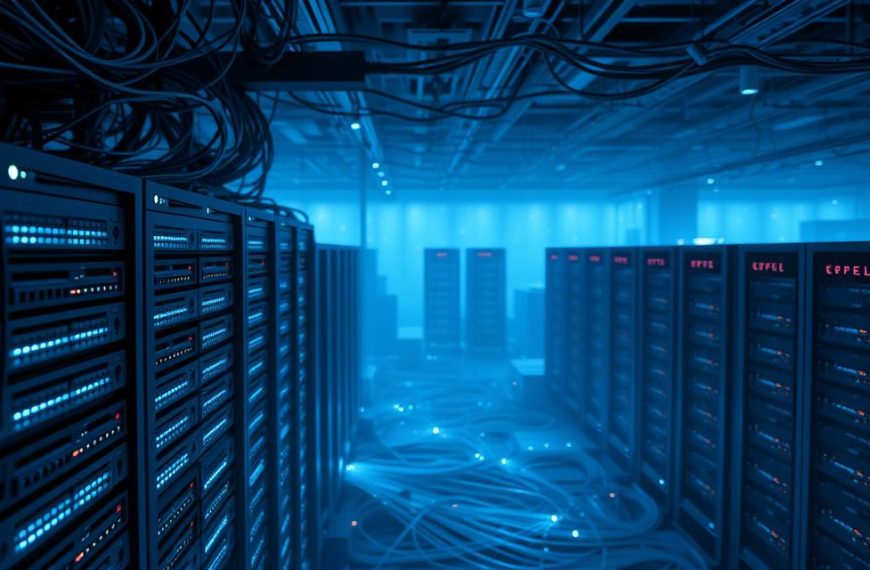Enhancing your gaming system doesn’t have to break the bank. With strategic improvements, you can boost performance while staying within a budget. Focus on components that offer the best value for money, like SSDs and HDDs, which can significantly improve load times and storage capacity.
For example, a $40 HDD or a $100 SSD can make a noticeable difference. These upgrades not only improve your experience but also extend the lifespan of your system. With current hardware availability in 2024, now is a great time to invest in these improvements.
Supply chain challenges in recent years have made it essential to act quickly. Expert guides, like those from PCWorld, recommend focusing on sub-$100 upgrades for maximum impact. This guide provides actionable, brand-specific advice verified by multiple authoritative sources.
Introduction: Why Upgrade Your Gaming PC on a Budget?
Affordable improvements can breathe new life into your existing setup. The post-pandemic hardware market has faced significant challenges, including supply chain disruptions and rising costs. These factors make targeted upgrades a smarter choice than replacing your entire system.
On average, a gaming rig lasts 2-4 years without enhancements. After three years, 72% of users report noticeable performance issues. Thermal throttling, caused by overheating components, often reduces efficiency. Addressing these problems can extend your system’s lifespan.
For example, investing in an SSD can deliver 2-5x faster load times compared to traditional HDDs. AMD’s AM4 platform, introduced in 2017, remains a reliable option for cost-effective upgrades. Tools like Crucial’s System Scanner ensure compatibility with your current setup.
Benchmark testing helps measure the impact of these changes. It’s essential to evaluate the return on investment (ROI) for each upgrade. Below is a cost comparison of targeted improvements versus a full system replacement:
| Upgrade | Cost | Performance Gain |
|---|---|---|
| $150 GPU | $150 | Improved graphics and frame rates |
| $100 SSD | $100 | 2-5x faster load times |
| Full System Replacement | $1,500+ | Complete overhaul |
By focusing on specific components, you can achieve significant performance boosts without overspending. This approach ensures your gaming rig remains competitive and efficient for years to come.
1. Upgrade Your RAM for Better Performance
Boosting your system’s performance starts with a simple yet effective upgrade. Adding more RAM can significantly improve speed and multitasking capabilities. Modern games like Forza Horizon 5 require at least 12GB of memory, making this upgrade essential for smooth gameplay.
How Much RAM Do You Need?
For most gaming setups, 16GB is the sweet spot. This capacity ensures smooth operation for modern titles and multitasking. Dual-channel configurations, which use two sticks of RAM, offer better performance than single-channel setups. Tools like CPU-Z can help verify compatibility with your system.
Best Budget RAM Options
The Kingston HyperX Fury 3200MHz 16GB kit is a reliable choice, priced at $68. For tighter budgets, an 8GB DDR4-3200 kit from Crucial Pro costs around $50. Laptop users can opt for a 4GB SO-DIMM module at $25. Always purchase from reputable brands to avoid reliability issues with no-name products.
When installing RAM, handle modules by the edges and ground yourself to prevent static damage. Matched pairs, like those from Crucial, ensure optimal performance. Prices vary across retailers like Newegg, Amazon, and B&H, so compare before buying.
2. Switch to an SSD for Faster Load Times
Switching to an SSD can transform your system’s speed and efficiency. Unlike traditional HDDs, SSDs use flash memory, which eliminates moving parts and significantly reduces load times. This upgrade is especially beneficial for games, where faster loading can enhance the overall experience.
SSD vs HDD: What’s the Difference?
HDDs rely on spinning disks and mechanical arms to read data, which limits their speed. In contrast, SSDs access data instantly, resulting in boot times as fast as 15 seconds compared to 45 seconds with HDDs. For performance-intensive tasks, SSDs are the clear winner.
Modern SSDs also feature DRAM cache, which improves write speeds and longevity. Avoid QLC NAND drives for write-heavy uses, as they may degrade faster. For bulk storage, consider pairing an SSD with a WD Blue 4TB HDD for cost-effective capacity.
Affordable SSD Recommendations
Here are some budget-friendly SSD options that deliver excellent performance:
- Samsung 870 EVO 500GB: $70, known for reliability and speed.
- SK Hynix S31 500GB: $53, a great value with a 5-year warranty.
- Adata SU800: A budget alternative with solid performance.
When choosing between SATA and NVMe drives, consider your hardware compatibility. NVMe drives offer faster speeds but come at a higher cost. For most users, a SATA SSD provides the best balance of price and performance.
Whether you clone your existing drive or perform a fresh install, ensure your data is backed up. Tools like Acronis True Image simplify the migration process, making the upgrade seamless.
3. How to Upgrade Your Gaming PC Cheap with a New Graphics Card
A new graphics card can breathe life into an aging system. Modern gaming titles demand more power, and upgrading your GPU is a cost-effective solution. Whether you’re aiming for 1080p or 1440p resolutions, the right card can transform your experience.
Budget-Friendly Graphics Cards
For those on a budget, the AMD RX 6600 at $199 is a solid choice. It delivers excellent performance for 1080p gaming. If you’re looking for more power, the Nvidia RTX 4060 Ti offers 160W efficiency, ideal for 1440p setups. Always verify your PSU compatibility before purchasing.
When exploring the used market, exercise caution. Fake GPUs are a growing concern. Tools like GPU-Z can help verify authenticity. Additionally, ensure the card supports PCIe 4.0, which is backward compatible with older systems.
Choosing the Right GPU for Your System
Consider your resolution needs. For 1080p, 8GB of VRAM is sufficient. For 1440p, opt for cards with 12GB or more. The AMD RX 7600 at $269 is a great mid-range option. Pair it with a PSU that meets the card’s wattage requirements.
Power connectors also matter. Some cards use daisy-chain connectors, while others require separate cables. Always check your PSU’s capacity to avoid bottlenecks. Use a bottleneck calculator to ensure your components work harmoniously.
Finally, compare GDDR6 and GDDR6X memory. The latter offers faster speeds but comes at a higher cost. For most users, GDDR6 provides the best balance of price and performance.
4. Improve Your CPU for Enhanced Processing Power
Maximizing processing power can elevate your system’s capabilities. A powerful CPU ensures smoother multitasking, faster load times, and better overall performance. Whether you’re running modern games or demanding applications, upgrading your processor is a smart move.
Modern CPUs come with higher core and thread counts, which are essential for multitasking. For example, the AMD Ryzen 5 5600 offers 6 cores and 12 threads, making it ideal for gaming and productivity. Similarly, the Intel i5-12400F provides excellent value with its 6 cores and 12 threads.
Best Budget CPUs for Gaming
When choosing a CPU, consider your budget and hardware compatibility. Here are two top options:
- AMD Ryzen 5 5600: Priced at $149, this processor delivers exceptional performance for its cost. It’s compatible with AM4 socket motherboards and supports PCIe 4.0.
- Intel i5-12400F: At $159, this CPU offers great value for Intel users. It’s part of the Alder Lake architecture, known for its efficiency and speed.
Both processors are excellent choices for gamers and content creators. They provide a significant upgrade over older models, ensuring your system remains competitive.
Compatibility Considerations
Before upgrading your CPU, ensure it’s compatible with your motherboard. For example, the AM4 socket supports Ryzen processors, while Intel’s LGA 1700 socket is designed for Alder Lake CPUs. Check your motherboard’s chipset, such as B550 or X570 for AMD, to confirm compatibility.
Some systems may require a BIOS update to support newer processors. Always verify this before purchasing. Additionally, consider PCIe lane allocations, as newer CPUs support PCIe 4.0 or 5.0, offering faster data transfer rates.
For cooling, the Cooler Master Hyper 212 is a reliable and affordable option. Proper thermal paste application is also crucial to prevent overheating. Avoid OEM systems, as they often have limitations on upgrades.
“A well-chosen CPU can transform your system’s performance, making it a worthwhile investment.”
Here’s a comparison of the two processors based on PassMark benchmarks:
| CPU | PassMark Score | Price |
|---|---|---|
| AMD Ryzen 5 5600 | 22,000 | $149 |
| Intel i5-12400F | 21,500 | $159 |
Both processors offer excellent value, but the Ryzen 5 5600 slightly outperforms the i5-12400F in benchmarks. Choose based on your system’s needs and compatibility.
5. Add More Storage for Your Growing Game Library
Modern games demand significant storage space, making upgrades essential. Titles like Call of Duty can require up to 200GB, quickly filling your drive. Expanding your storage ensures smoother gameplay and better organization.
HDD vs SSD for Additional Storage
When choosing between HDDs and SSDs, consider your needs. HDDs offer larger capacities at lower costs, making them ideal for bulk storage. For example, the Seagate BarraCuda 2TB costs just $57. However, SSDs like the Crucial P3 1TB NVMe deliver faster load times and better performance for $63.
HDDs use spinning disks, while SSDs rely on flash memory. For games, SSDs reduce load times significantly. RAID 0 configurations can improve HDD performance, but SSDs remain the superior choice for speed.
Affordable Storage Solutions
Here are some budget-friendly options to expand your storage:
- Seagate BarraCuda 2TB: $57, ideal for bulk data.
- Crucial P3 1TB NVMe: $63, perfect for faster load times.
- WD Blue 4TB HDD: A cost-effective solution for large libraries.
For external options, portable SSDs provide flexibility. Cloud storage is another alternative, though it requires a stable internet connection. Always verify compatibility with your components before purchasing.
Learn more about internal and external storage options to make the best choice for your setup.
6. Upgrade Your Power Supply for Better Stability
A stable power supply is the backbone of any efficient setup. Without it, even the most advanced components can underperform or fail. Upgrading your power supply ensures your system runs smoothly, especially when paired with high-demand hardware like modern GPUs.
How to Choose the Right Power Supply
Start by understanding 80 Plus efficiency ratings. These certifications indicate how effectively a power supply converts AC power to DC. Higher ratings, like 80 Plus Gold or Platinum, reduce energy waste and heat output. Modular PSUs offer better cable management, while non-modular options are more budget-friendly.
Ensure your PSU has the right connectors for your card. Most GPUs require 6+2 pin connectors. Calculate your total system wattage using online tools to avoid overloading your power supply. Japanese capacitors are more reliable than Chinese ones, offering better longevity and stability.
Look for protections like Over Current Protection (OCP) and Over Voltage Protection (OVP). These features safeguard your components from damage. Avoid no-name brands, as they often lack these critical safety measures.
Budget Power Supply Options
Here are two reliable PSUs that balance cost and performance:
- Corsair CX650M: Priced at $79, this modular PSU offers 80 Plus Bronze efficiency and excellent cable management.
- EVGA 600 BR: At $64, this non-modular option provides 80 Plus Bronze certification and reliable performance.
Investing in a surge protector can further protect your system. Proper cable management improves airflow, reducing heat buildup. Future-proof your setup by choosing a PSU with higher wattage than your current needs.
“A reliable power supply is the foundation of a stable and efficient system.”
Here’s a comparison of the two PSUs:
| Model | Efficiency | Price |
|---|---|---|
| Corsair CX650M | 80 Plus Bronze | $79 |
| EVGA 600 BR | 80 Plus Bronze | $64 |
Choosing the right power supply ensures your system remains stable and efficient. It’s a small investment that pays off in the long run.
7. Enhance Your Cooling System for Optimal Performance
Keeping your system cool is essential for maintaining peak performance. Overheating can damage components and reduce efficiency. A well-designed cooling setup ensures your hardware runs smoothly and lasts longer.
There are two main types of cooling solutions: air and liquid. Air cooling is cost-effective and easy to install, while liquid cooling offers superior heat dissipation. The Cooler Master Hyper 212 is a popular air cooler, priced at $40, and delivers excellent performance for its cost.
Affordable Cooling Solutions
For budget-conscious users, the Thermaltake Riing 120mm fan at $12 is a great option. It combines affordability with solid airflow. Pair it with Arctic Silver 5 thermal paste for $7 to improve heat transfer. These upgrades can significantly enhance your system’s thermal management.
When choosing fans, consider static pressure for radiators and airflow for case ventilation. Negative pressure setups pull air out, while positive pressure pushes it in. Both have their advantages, depending on your case design.
How to Install a New Cooling System
Start by selecting the right components for your hardware. Ensure compatibility with your case and motherboard. Tools like SpeedFan can help monitor temperatures and fan speeds during installation.
For air coolers, apply thermal paste in a pea-sized amount on the CPU. Secure the heatsink firmly to avoid gaps. For liquid cooling, follow the manufacturer’s instructions carefully to prevent leaks. Always test your setup before closing the case.
Monitoring software like HWInfo provides real-time data on your system’s thermal performance. Regularly check for dust buildup and clean your fans to maintain optimal airflow.
8. Upgrade Your Peripherals for a Better Gaming Experience
Transform your setup with high-quality peripherals that don’t strain your wallet. The right accessories can significantly enhance your gaming sessions, offering better control, clarity, and comfort. From monitors to keyboards, these upgrades ensure a smoother and more immersive experience.
Best Budget Gaming Monitors
Choosing the right monitor is crucial for optimal visuals. TN panels are affordable but offer limited viewing angles. IPS panels provide better color accuracy, while VA panels deliver deeper contrasts. For fast-paced games, a 144Hz refresh rate ensures smooth motion.
The ViewSonic XG2405 is a standout option at $199. It features FreeSync technology, reducing screen tearing for seamless gameplay. Calibration tools like DisplayCAL help fine-tune settings for accurate colors and brightness.
Affordable Keyboards and Mice
Mechanical keyboards like the Logitech G610 Orion ($80) offer durability and tactile feedback. Cherry MX switches are ideal for precise inputs, while macro keys streamline complex commands. For mice, the Razer DeathAdder V2 ($44) provides customizable DPI settings, perfect for FPS games.
Consider desk space when selecting peripherals. Compact keyboards save room, while anti-fatigue mats improve comfort during long sessions. RGB customization adds a personal touch, and wired options minimize latency for competitive play.
| Peripheral | Price | Key Features |
|---|---|---|
| ViewSonic XG2405 | $199 | 144Hz, FreeSync, IPS panel |
| Logitech G610 Orion | $80 | Cherry MX switches, macro keys |
| Razer DeathAdder V2 | $44 | Customizable DPI, ergonomic design |
Investing in the right peripherals ensures your system delivers peak performance. These upgrades not only enhance your gaming experience but also provide long-term value.
9. Optimize Your PC’s Settings for Free Performance Boosts
Unlocking your system’s full potential doesn’t always require spending money. By fine-tuning your settings, you can achieve noticeable improvements in performance. This section explores practical steps to enhance your setup without breaking the bank.
How to Update Drivers
Keeping your drivers up to date is crucial for optimal performance. Outdated drivers can cause lag and compatibility issues. Use tools like DDU (Display Driver Uninstaller) to cleanly remove old drivers before installing new ones.
For GPU optimization, MSI Afterburner is a powerful tool. It allows you to overclock your graphics card safely, boosting frame rates in demanding games. Always monitor temperatures to avoid overheating.
Tips for Improving Performance Without Upgrading
Start by optimizing your BIOS settings. Enable features like XMP for faster RAM speeds. Disable unnecessary startup programs to free up system resources. Tools like CCleaner can help clean your registry and remove junk data.
Adjust your page file settings for better memory management. Allocate more virtual memory if you frequently run memory-intensive programs. Additionally, use Nvidia Control Panel to tweak game-specific settings for smoother gameplay.
- Kill background processes using Task Manager.
- Run malware scans to remove unwanted programs.
- Set up a RAM disk for faster data access.
“Small tweaks can lead to big improvements in your system’s efficiency.”
Finally, avoid using registry “optimizers” that promise unrealistic boosts. These tools often cause more harm than good. Stick to trusted methods and tools for reliable results.
Conclusion: Maximize Your Gaming PC’s Potential on a Budget
Achieving peak performance doesn’t require a complete overhaul. Focus on strategic upgrades like SSDs, RAM, and GPUs to enhance your experience without overspending. Always verify component compatibility to avoid costly mistakes.
Adopt a phased approach to upgrades. Start with essential improvements, then expand as your budget allows. Trade-in programs can help offset costs, while regular maintenance ensures your system remains efficient.
Be cautious of counterfeit parts. Stick to reputable brands and use tools like GPU-Z for authenticity checks. Monitor your system’s performance with software like HWInfo to identify areas for improvement.
Finally, stay informed about emerging technologies like PCIe 5.0. These advancements offer future-proofing opportunities, ensuring your setup remains competitive. With careful planning, you can maximize your gaming rig’s potential while staying within budget.











